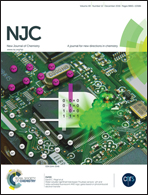Synthesis and molecular structures of divalent bridged bis(guanidinate) europium complexes and their application in intermolecular hydrophosphination of alkenes and alkynes†
Abstract
The reaction of anhydrous EuCl3 with one equiv. of lithium salt of a three-carbon bridged bis(guanidinate) Li2L1 (L1 = [iPr(Me3Si)NC(NiPr)N(CH2)3NC(NiPr)N(SiMe3)iPr]) in THF afforded chloride EuIIIL1Cl(THF)2 (1). The reduction reaction of complex 1 with Na/K alloy in a molar ratio of 1 : 1.2 in THF gave a novel EuII complex supported by an unexpected new bridged bis(guanidinate) ligand L3, [EuIIL3]2 (L3 = [iPr(Me3Si)NC(NiPr)N(CH2)3N(SiMe3)C(NiPr)2]) (2), through the redistribution of one guanidinate in L1 during the reduction. Complex 2 was structurally characterized to be a binuclear complex in which two Eu metals are connected together by two L3 ligands that adopted a μ-η1:η2:η2 coordination mode for one L3 ligand and a μ-η2:η2:η2 mode for the other. Treatment of the in situ formed EuIIIL2Cl(THF)2 (L2 = 1,8-C10H6{NC(NiPr)(NHiPr)}2) by the reaction of EuCl3 with 0.5 equiv. of [Li2L22Li2] in THF with Na/K alloy yielded a novel EuII complex [EuIIL2(THF)]2 (3) in good yield. Complex 3 was characterized by an X-ray crystal structure analysis. Complex 3 features an unusual μ-η1:η2:η2 coordination mode of the bridged bis(guanidinate) ligand onto EuII. Complexes 2 and 3 are efficient pre-catalysts for the intermolecular hydrophosphination of alkenes and alkynes to give exclusively anti-Markovnikov products and mainly anti-addition products for the alkyne reactions. For these transformations, the best performances were observed with complex 2.


 Please wait while we load your content...
Please wait while we load your content...